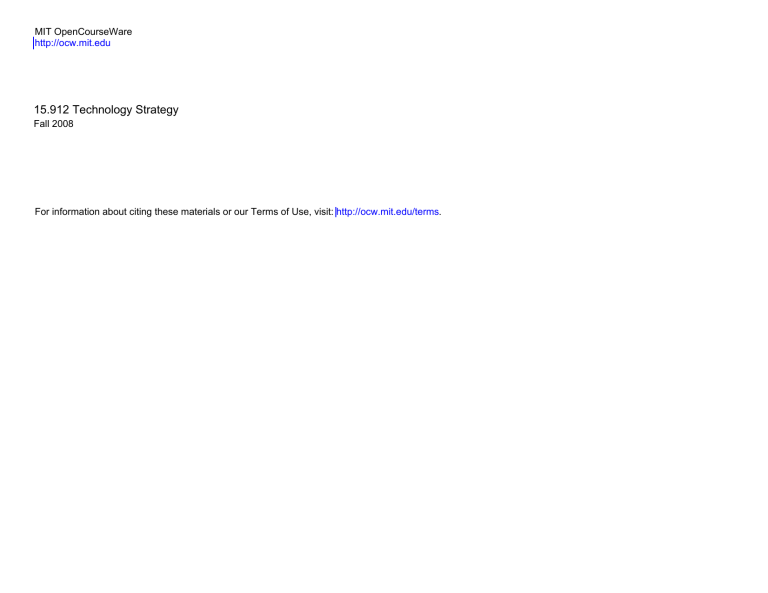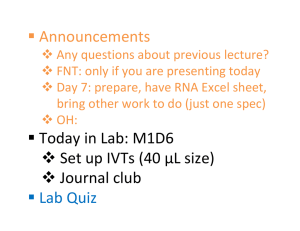Document 13617988

MIT OpenCourseWare http://ocw.mit.edu
15.912 Technology Strategy
Fall 2008
For information about citing these materials or our Terms of Use, visit: http://ocw.mit.edu/terms .
The Story So Far
Professor Jason Davis
MIT Sloan School of Management
Outline
• Strategy fundamentals
– Creating, capturing and delivering value
• Technology strategy:
– Taking value creation for granted now
– Exploring the dynamics of value capture
– Moving too organizational dynamics as a fundamental source of long term competitive advantage – integrating value delivery into value capture
Strategy Fundamentals
Strategy fundamentals
How will we
Create value?
How will we
Deliver value?
How will we
Capture value?
Strategy Fundamentals
• Create value: Choose a “good” industry
– One with a large “PIE”
• Capture value: Create a source of sustained competitive advantage
– Choose/create a “favorable” industry structure
– Build assets/competencies/resources that cannot be bought on the open market
– Build assets/competencies/resources that cannot be instantaneously built
• Capture value:
– Align the organization with the strategy
“Choose” an industry with a “favorable” industry structure
Low threat of entry
Many, fragmented
Suppliers
Weak
Rivals
Weak
Substitutes
Many, fragmented
Buyers
Technology Strategy: What’s new?
Thinking explicitly, about dynamics:
S ‐ curves, industry lifecycle, chasm, innovators dilemma, effective
Performance organization processes
Maturity
Discontinuity
Takeoff
Ferment
Time
Taking
value
creation
for
granted…
How will we
Create value?
How are technologies likely to evolve?
How will we
Deliver value?
Will this technology serve an addressable market?
How will we
Capture value?
Two key ideas:
• Uniqueness
– Controlling the knowledge generated by an innovation
• Complementary assets
– Controlling the assets that maximize the profits from innovating
Thinking about tightly held complementary assets
• “Raw” first mover advantage: acquiring an asset before others realize its value
– Land, location, people….
• Building an asset that others cannot imitate
– Tacit skills?
Company cultures?
Ways of doing things?
• More sophisticated “first mover” advantage: taking advantage of increasing returns before others
– Learning curves, Network effects, Brands,
Technological skills….
The best complementary assets are tightly held
Tightly held
Only we have access to it
Only we can do it
Only people in our industry can access it
Only people in our industry can do it
Anyone can do it
Anyone can access it
Freely available
The sources of advantage usually change over time…
Complementary assets are:
Available Tightly held
Possible
Uniqueness is:
Very
Difficult
$
Platforms and Network Effects
• Winner ‐ Take ‐ All and Network Effects: Will it tip?
– Are their direct network effects?
• Markets where $/user depends on number of users
• Example: Fax Machines
– Are their indirect network effects?
• 2 ‐ sided markets like eBay
– What are the costs of multi ‐ homing?
• Example: Video Game Consoles
• That is, users and suppliers switching back and forth
– Demand for differentiated platform?
• Can you differentiate?
Where we’re going next…
• Value Capture:
– More to know about platform ‐ based industries…
– …foreshadow some “value delivery” by thinking about how to manage platforms and ecosystems.
– Rethinking the Value Chain
• Value Delivery:
– Making Decisions in High Velocity Environments
– Product Development & Organizational Rhythms
– Overload and Commitment
– Managing Partnerships: Alza/Ciba Two ‐ Day Alliance
Role Play

